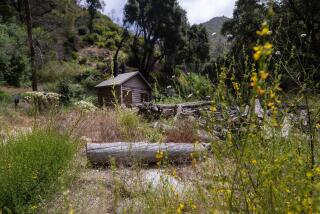Piles of poop, toilet paper ‘flowers’ greet rangers as parks reopen after government shutdown
- Share via
In Death Valley, piles of human feces and hunks of what rangers call “toilet paper flowers” were left scattered around the desert.
At Joshua Tree, officials found about 24 miles of unauthorized new trails carved into the desert landscape by off-road vehicles, along with some of the park’s namesake trees toppled.
For the record:
1:30 p.m. Feb. 1, 2019An earlier version of this article included a photo which incorrectly identified a Joshua tree as having been cut down by vandals during that time. Although a park ranger initially identified the tree as part of the vandalism, park officials now say the tree was downed as a result of wind damage.
And at Point Reyes along the Marin County coast, a colony of elephant seals made a popular beach their new home and welcomed 40 new pups into the world.
With the partial federal government shutdown over — at least for now — authorities are beginning the tally to damage that occurred to some of California’s national parklands during the weeks in which many park officials were off the job.
While volunteers tried to keep the peace, officials returned to find humans — and some creatures — had taken advantage of the lack of supervision.
In the end, park officials said the damage to the parks was scattered but not widespread. The cleanups are underway, and that includes removing vandalism and fixing up trashed facilities.
During the shutdown, some reports “made it sound like it was the Wild West,” said George Land, a Joshua Tree spokesman. “While there was a certain segment of the population like that, the majority of visitors love this area and love the park and behaved themselves. This is not a virtual wasteland.”
Some of the most concerning losses involved three Joshua trees that were cut down or damaged and two mature juniper trees were cut for firewood along with dozens of cat claw acacia trees, said park superintendent David Smith.
Joshua Tree — which was on track to have more than 3 million visitors in 2018 — also missed out on roughly $1.03 million in entrance fees, Land said.
“I don’t want to put everything in dollars and cents, but sometimes it comes down to that,” he said.
Former Joshua Tree Supt. Curt Sauer decried the destruction at the park along with dozens of other people at a rally over the weekend. He estimated it could take centuries for the park’s namesake trees and other sensitive vegetation to recover from damage inflicted during the shutdown. Some trees appear to have been chopped down, but Land said rangers don’t know how many were harmed or how the destruction was caused.
“There appear to be trees that people may have hooked hammocks onto or did some damage to,” he said.
Joshua trees grow slowly, only about an inch to an inch and a half a year, Land said.
In addition to the trees, off-road drivers cut destructive scars in the desert floor’s delicate biological soil crust. Advocates had warned of such damage during the shutdown and called for the park to be closed entirely.
Joshua Tree staff also discovered evidence of more than 100 campfires outside designated campsites, Land said.
At Death Valley National Park, government workers have counted 40 piles of human feces and more than 1,400 wads of toilet paper, spokeswoman Abby Wines said.
So much human waste piled up in Yosemite National Park from visitors using the side of the road as a toilet during the shutdown that officials closed two campgrounds and a popular redwood grove, citing public safety concerns. But park officials say it was spared any long lasting damage.
Yosemite National Park employees are faced with other tasks like getting back to work on deferred maintenance, working out the kinks in the payroll system, and hiring seasonal workers before the summer season starts, said park spokesman Scott Gediman.
“The park itself looks great,” he said.
And not all of the imprints left at the national parks have been from humans.
North of San Francisco at Point Reyes National Seashore, the lack of people provided an opening for a colony of elephant seals to move onto Drakes Beach, leading officials to close off vehicle, foot and bicycles traffic on the access road leading to the popular shore area.
“It was the perfect storm,” said park spokesman John Dell’Osso. “We had king tides, a literal storm and nobody walking up and down the beach for a week.”
Had park staff been on hand, they would have shooed the large marine mammals away.
At Death Valley, the impact of the government shutdown includes things that didn’t happen. At least five school field trips to the park were canceled and nearly 150 educational programs were scrapped, including guided hikes and presentations on native animals and geology that would have served about 6,000 visitors, officials said.
The park also skipped its popular night-sky program, where rangers set up four telescopes to let visitors look at the Milky Way on moonless evenings.
“That is by far our most popular program,” Wines said. “We help people connect to the stars and how our ancestors used the stars.”
She said the park was able to keep five staffers at a visitor center during the shutdown, thanks to $40,000 from the Death Valley Natural History Assn. Those staffers advised visitors on how to properly defecate in the wild once the park’s pit toilets got full: Dig a hole 8 inches deep, do your business, then cover it up and put your toilet paper in a sealed plastic bag.
But not everyone heeded the advice.
“It smells bad; it is gross,” she said. “It can sometimes make animals sick … [and] change the behavior of wildlife.”
Park advocates are already bracing for the possibility of another government shutdown since the continuing resolution President Trump signed only reopens the federal government through Feb. 15.
“I think there is some relief but there is not much,” said David Lamfrom the director of the California desert and national wildlife programs for the National Parks Conservation Assn. “The shadow of another looming shutdown is there.”
He said steady rain in the desert could lead to a wildflower bloom in the coming weeks — and more headaches if thousands of visitors descend on the parks while the government is closed.
“People really really need to understand how fragile these parks are and the role the park services plays maintaining them and teaching the public about the parks,” said Lamfrom.
More to Read
Sign up for Essential California
The most important California stories and recommendations in your inbox every morning.
You may occasionally receive promotional content from the Los Angeles Times.











